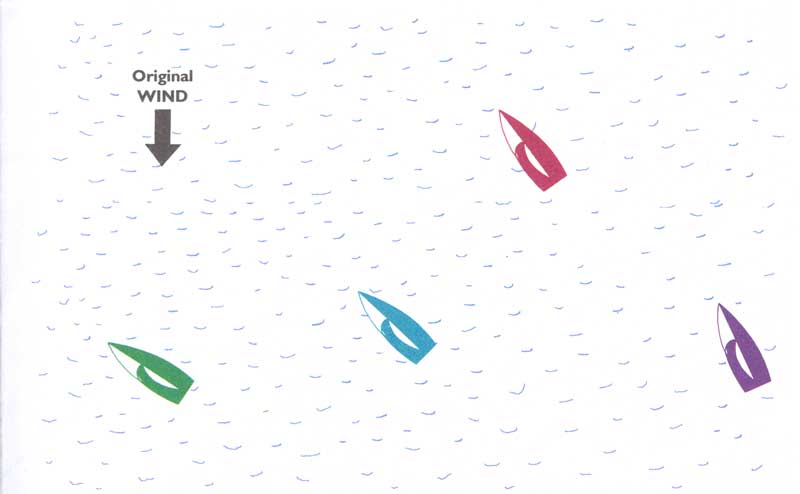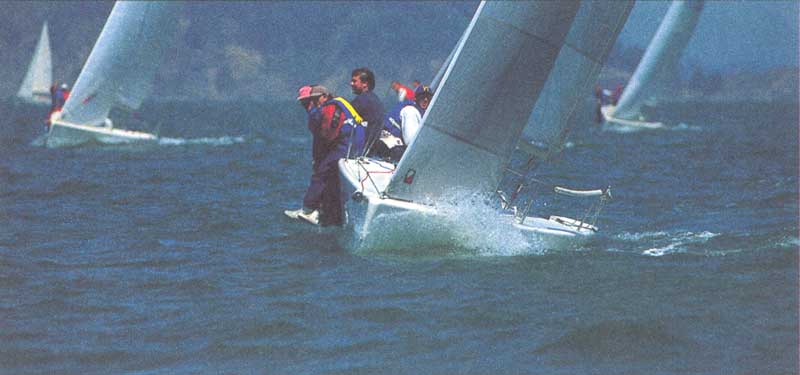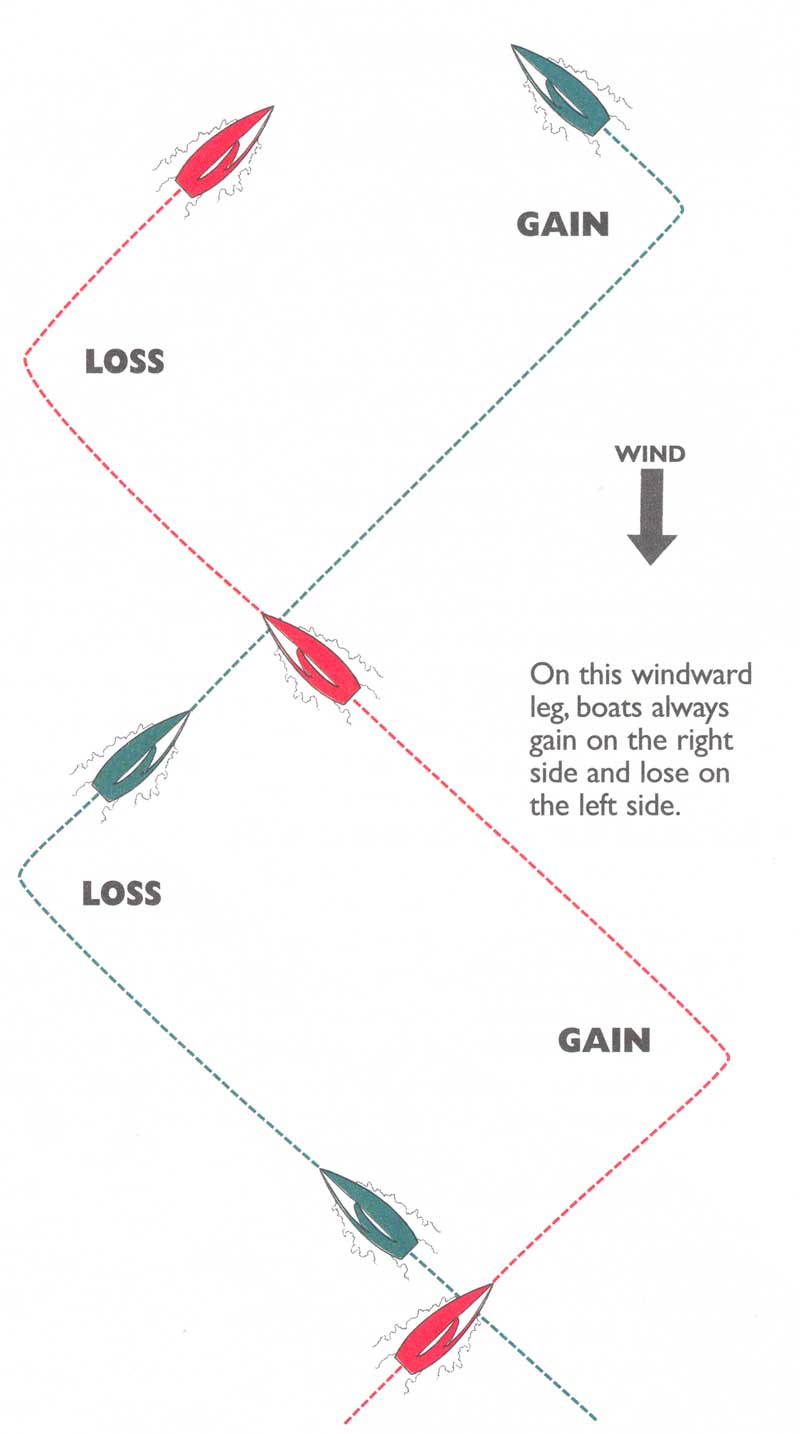How You Can Tell When the Wind is
Shifting Persistently
by David Dellenbaugh
 |
As Iíve said many times, itís critical to figure out whether the
windshifts during your race will be oscillating or persistent. Here are some
related visual clues that youíll see before or during a persistent shift.
None of these are absolute indicators, but their presence will increase your
chances of getting a persistent shift.
The wind is blowing across open water.
When your sailing wind is blowing from the land, itís likely you will have
an oscillating shift pattern. But when the wind direction is onshore (i.e.
thereís not any land mass close to windward), you are likely to have a
steadier wind that may slowly shift persistently.
There is land on one side of the course.
Whenever you have a shoreline that is closer to one side of the course, you
should automatically consider the possibility that this land will exert a
geographic influence on the wind. It is likely you will have a persistent
wind shift as you get closer to shore.
There is a significant current in the course area.
Any time you have current there is a good chance this will affect the wind
direction. However, you will see a persistent shift only when there is a
difference (or a change) in current strength or direction across the course.
Your heading on each tack moves steadily in one direction.
When you record pre-race compass headings on port and starboard tack, you
notice that these move slowly in one direction over time. For example, you
may start off sailing 265 degrees on port tack, and 30 minutes later your
heading is 275 degrees (see chart below right). A persistent breeze doesnít
oscillate very much, and shifts happen more gradually.
Boats are progressively lifted (or headed) across the course.
When you look around the course, you can see boats that are lifted the most
on one side of the course and boats that are lifted the least on the other
(see diagram at right). They are not randomly lifted and headed like you
would see with an oscillating breeze.
You are sailing in a thermal breeze.
The classic seabreeze may have a few oscillations, but it generally shifts
persistently. As it builds in the early afternoon it slowly moves in one
direction (usually to the right in the northern hemisphere) and then shifts
slowly back the other way as it dies later in the afternoon.
The wind on the water looks solid in direction and velocity.
When you see dark and light spots (puffs and lulls) across the race course,
thereís a good chance the wind direction is oscillating. But when it looks
solid and consistent, youíre more likely to have a persistent shift.
 |
On the first beat, the same tack is always longer.
In an oscillating breeze, either tack might be longer to the windward mark.
In a right-hand shift your bow will point closer to the mark on starboard
tack; in a left-hand shift youíll sail longer on port tack. But when you
have persistent shift, one tack will always be longer during a windward leg
(or run). As you sail up the leg, that tack will become relatively longer.
 |
| A persistent windshift is often reflected in the angels that boats
are sailing on a windward leg. Instead of random lifts and headers (like
in an oscillating breeze), you see boats that are lifted or headed in a
pinwheel array. Their sailing angle is proportional to their proximity
to the shift. In the diagram above, it looks like the wind is shifting
to the right because the farther you go in that direction, the more each
boat is lifted. Also, most of the time when you have a persistnet shift,
the wind looks fairly steady and consistent across the course (right).
You donít see puffs and lulls that come with oscillating winds. Photo by J.H. Peterson. |
Boat gain (and lose) on one side of the course.
When the wind is shifting steadily in one direction, every gain will be made
by boats on that side of the course. Unlike an oscillating breeze, you wonít
see boats gaining first on the right and then on the left. During the first
part of the beat, watch how boats are crossing each other - this will tell
you where they are gaining (and therefore where the wind is shifting).
 |
| One good clue about the windshift pattern is the relative performance of boats on the windward leg. For example, if boats make gains on both the left and right sides of the course, you probably have an oscillating breeze. But if one side of the course is always better (above), then you most likely have a persistent shift. So keep an eye on how you fare with other boats during the early part of every beat. |
One end of the start line becomes more favored.
Have you noticed that, in some conditions, itís difficult for the race
committee to keep the starting line square to the wind? The pin may start
off favored by 3 degrees and then, ten minutes later, itís favored by 9
degrees. This is often a telltale sign that the wind is shifting
persistently.
Look for the presence of wind sheer.
When the wind is going to shift in one direction, it often shifts that way
first aloft. This change in wind direction at different heights is called
wind sheer. If you have a tall mast and you know how to recognize sheer,
this can be a reliable predictor of impending changes in wind direction.
Dave publishes the newsletter Speed & Smarts. For a subscription call:
800-356-2200 or go to:
www.speedandsmarts.com.
All contents are copyright (c) 2007 by
Northern Breezes, Inc. All information contained within is deemed reliable
but carries no guarantees. Reproduction of any part or whole of this
publication in any form by mechanical or electronic means, including
information retrieval is prohibited except by consent of the publisher.